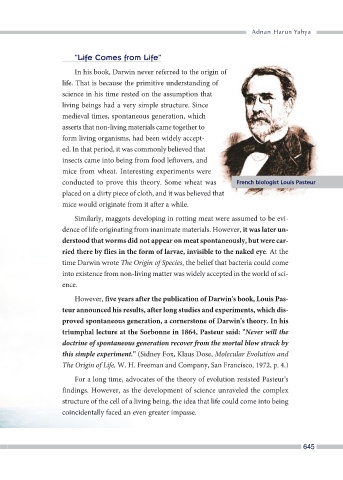Page 647 - Mastermind: The Truth of the British Deep State Revealed
P. 647
Adnan Harun Yahya
"Life Comes from Life"
In his book, Darwin never referred to the origin of
life. That is because the primitive understanding of
science in his time rested on the assumption that
living beings had a very simple structure. Since
medieval times, spontaneous generation, which
asserts that non-living materials came together to
form living organisms, had been widely accept-
ed. In that period, it was commonly believed that
insects came into being from food leftovers, and
mice from wheat. Interesting experiments were
conducted to prove this theory. Some wheat was French biologist Louis Pasteur
placed on a dirty piece of cloth, and it was believed that
mice would originate from it after a while.
Similarly, maggots developing in rotting meat were assumed to be evi-
dence of life originating from inanimate materials. However, it was later un-
derstood that worms did not appear on meat spontaneously, but were car-
ried there by flies in the form of larvae, invisible to the naked eye. At the
time Darwin wrote The Origin of Species, the belief that bacteria could come
into existence from non-living matter was widely accepted in the world of sci-
ence.
However, five years after the publication of Darwin's book, Louis Pas-
teur announced his results, after long studies and experiments, which dis-
proved spontaneous generation, a cornerstone of Darwin's theory. In his
triumphal lecture at the Sorbonne in 1864, Pasteur said: "Never will the
doctrine of spontaneous generation recover from the mortal blow struck by
this simple experiment." (Sidney Fox, Klaus Dose, Molecular Evolution and
The Origin of Life, W. H. Freeman and Company, San Francisco, 1972, p. 4.)
For a long time, advocates of the theory of evolution resisted Pasteur's
findings. However, as the development of science unraveled the complex
structure of the cell of a living being, the idea that life could come into being
coincidentally faced an even greater impasse.

